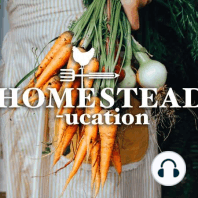1 min listen
Introduction to Permaculture
FromHOMESTEADucation
ratings:
Length:
35 minutes
Released:
Feb 25, 2022
Format:
Podcast episode
Description
Introduction to PermaculturePermaculture directly means “permanent agriculture.” But in its truest form, permaculture is a way of planting crops, keeping animals and sustaining the farm or homestead in a way that mimics the intertwined growing systems found in nature. We can imitate and initiate these natural ecosystems to create healthier crops, less pests, increase crop yields and absorb more carbon into the soil. Where to startIncrease reliance on perennial plantsWhy perennials? Perennials have more plant matter (woody stems, strong plant tissue and large root systems). These plants absorb more carbon dioxide as a result as they have more room to store them within their plant fibers.Perennials do not need to be planted year after year which means less work!Perennials offer shelter to beneficial insects, birds and wildlife. This helps to control pests within the garden.Perennial plants help soil structure. Their expansive roots loosen compacted soil, aid in the prevention of erosion and some mine different nutrients from deep under the soil’s surface to help feed their surrounding companions.Think in terms of “layering plants” with companions when planting anythingGive both annuals and perennials supporting partners to attract pollinators, deter bad bugs, mine nutrients from deep within the soil, mulch and suppress weeds with low-growing groundcovers, fix nitrogen into the soil, and retain moisture with living mulches.Large scale permaculture plantings may include an overstory tree (large tree like chestnut or oak), a lower fruiting tree (apple), caneberries (elder or raspberries), flowering bulbs and herbs (daffodils, garlic, comfrey, etc.), and a groundcover (such as strawberries).An annual bed may include tomatoes, carrots, lettuce and radishes.Resources:Carrots Love TomatoesRestoration AgricultureSolve problems with plants and animals and begin weaving an ecosystemToo many ticks: Add guinea fowlToo many aphids: Employ ladybugsCabbage moth larvae eating brassicas? Interplant garlic.All animals must contribute to the whole and serve more than one purpose (such as just eggs and meat providers, etc.). Horses: Manure for compost, grazing circuit, plowing, parasite control for sheepCows: Manure for compost, grazing circuitSheep and Goats: Fleece which can be used as garden mulch, grazing circuit, clearing grassy brush, parasite control for horses, fertilizerGuinea Fowl: eat ticks and pests without scratching at lawns and gardens, spread manure in pastures looking for insects, fertilizerDucks: snail and slug control, fertilizer, clear garden and crop debrisChickens: insect and pest control (especially in vineyards), fertilizer, clear garden and crop debrisGeese: Snake, rat, mouse control, insects, weeding and pasture management, leave fertilizer behind, eat fallen orchard fruit, clear garden and crop debrisIntroduce pasture rotation systems to reduce hay and feed costs, promote faste
Released:
Feb 25, 2022
Format:
Podcast episode
Titles in the series (44)
HOMESTEADucation Trailer: Season 1 by HOMESTEADucation
